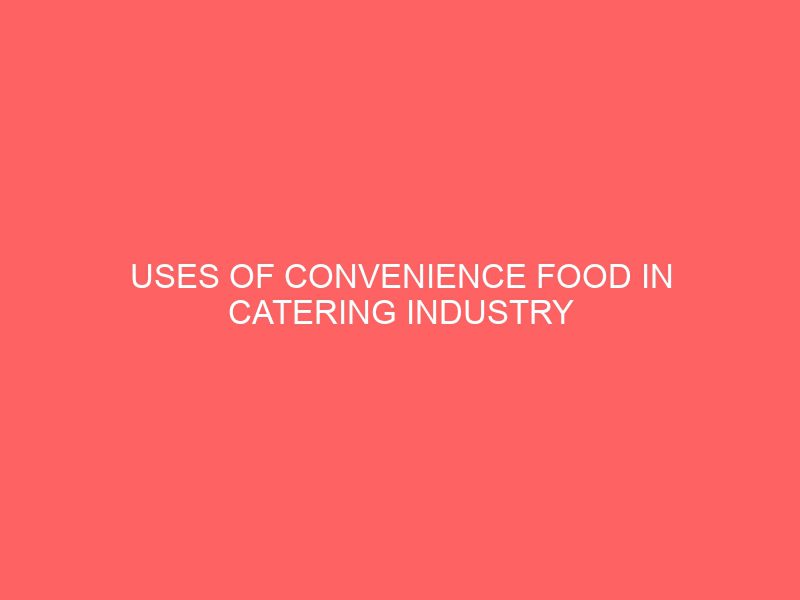Description
CHAPTER ONE
1.0 Introduction
This research is on uses of convenience food in catering industry. It would be wiser to begin this study with the mentioning of advancement in technology which has changed virtually the way people think, eat and select the choice of their meal. Due to the changes in the nature of life and the increasingly complex nature of people’s business and means of survival. It became imperative that foods that are consumed by people have changed from traditionally prepared foods to convenience foods.
The word convenience foods can be defined as any group of foods that requires little or no preparation and they can be served either hot or cold. Convenience foods may also include foods that have been processed from their raw state so that it becomes almost edible any may not requires any addition cooking.
These convenience foods have found their way into homes, offices, schools and even the hospitality industry. For the purpose of our study, the study shall be limited to the uses and effects of convenience foods in hospitality industry.
Due to the problem of meeting with the demand of coping with the complex situation of people’s job, an average consumer wants an array of food products that creates les work and allows them to spend more time seeking enjoyments, whether it is a special moment with their kids or with their job.
Nowadays, it is usual to shop occasionally and to maintain stores of dried, canned and frozen foods which can be used to prepare a meal quickly. Readymade dishes containing a variety of ingredients can now be purchased, saving time and effort. Some dishes which would require skill in preparation are very successful in the convenience form.
Convenience foods can be classified into three basic types:
- Canned foods: They are easy to store in a dry cupboard and they have a long-shelf life-they can either be served cold are:- sardines, fruit, ham and examples of those needed to be reheated are: vegetables, stew meat, etc.
- Dehydrated foods: These are light weight and easy to carry whole meals available are: and dry fish, dry meat, spaghetti etc.
Some dehydrated foods can be reconstituted instantly. Examples are powdered coffee and milk.
- Frozen foods: They are probably nearest in quality to fresh foods and we have a wide variety of foods in its category which are:- meat, poultry, fish, vegetables etc.
Some advantages of convenience goods are;
– It saves time in preparation
– The quality is consistent
– It can be stored in a cupboard or freezer for long periods
– There is no wastage
– They add variety to diet
While the major disadvantages are:
– Some types of foods are expensive foods and should be used with direction
– Vitamins B and C may be lost during processing.
The use of convenience foods has several functions which include increasing the appetite of consumers, complimenting traditional foods and above all, increasing the nutritional needs of an average consumer who visits a hospitable industry.
1.1 Scope of the Study
This study is to highlight the uses of convenience foods in catering industry.
The research work is designed to provide a thorough and glaring understanding of the various types and uses of convenience foods in catering industry.
1.2 Limitations of the Study
The study of the uses of convenience foods in catering industry is intended to be completed and comprehensive, there where a number of constraints in terms of cost, data, resources, time in the collection of data.
Despite all these constraints, the study is considered feasible and promising. Moreover due to the extended nature of the topic, It was not possible to cover the whole uses of convenience foods in the hospitality industry.
1.3 Objectives of the Study
The objectives of this study is to enlighten the entire populace most especially the staffs and employees of the catering industry on the uses of convenience foods in catering industry.
The project also lay emphasis on the benefit which the country and the staffs of the catering industry stand to gain from the uses of convenience foods, problems facing the hospitality industry to pay more attention to adoption of convenience food in the catering industry.
1.4 Significance of the Study
The man significance of this study includes the following:
– It will allow the staff to know the effectiveness of convenience foods
– It will educate the unskilled foods and beverage staff on the importance of using convenience foods.
– It will help the staff and employee of catering industry to know the impact of the uses of convenience foods in the industry.
1.5 Definitions of Terms
1.6.1 Fruit Juices: These are regarded as extracts of processed fruits which does not contain the addition of additives such as sugar or preservatives.
1.6.2 Fruit Drinks: These are regarded as the product obtained by the dilution of juices obtained from fruits and the addition of additives such as preservation, colorants and sugar.
1.6.3 Milk: It’s another terms define as the creamy whitish liquid produced from the mammary glands of mammals
1.6.4 Meat: Meat is the muscle derived from animals after slaughtering them. Meat can therefore be regarded as the post- mortem aspect of animal
1.6.5 Beverages: It is define as fluids that can be consumed without much preparation and are regarded as stimulant. It can either be alcoholic or non- alcoholic.
1.6.7 Butter and Margarine: Butter is a product that is obtained from the churning process of milk while margarine in a product that is obtained from the catalytic hydrogenation process of vegetable fat or oils.
1.6.8 Sugar: It can be described as sweetener. Sugar mainly consist of fructose and glucose.
1.6.9 Dehydration: This is the method of removing excessive water from food substance to prolong its life time.








Reviews
There are no reviews yet.